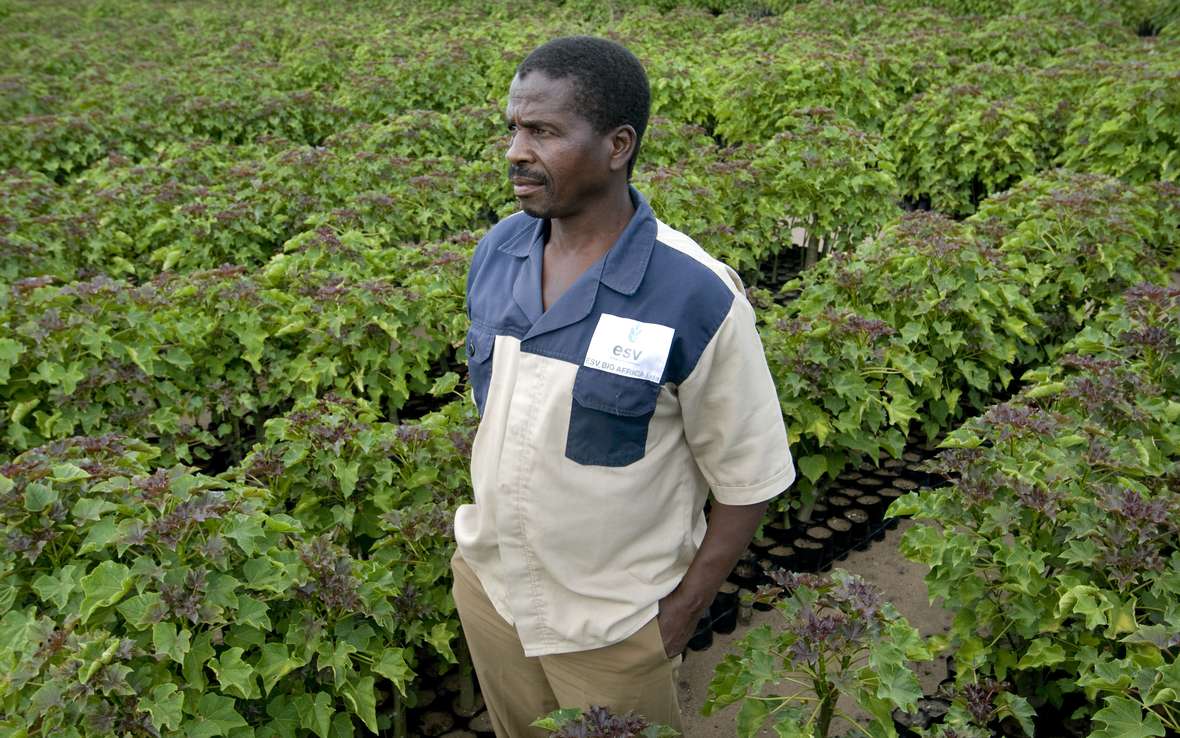In front of Alexander Maluleque’s house in Inhassune stands a leafy jatropha bush. It is a fixture in the middle of the village; people carve their initials in the bark, and Maluleque’s children play in the shade cast by its foliage, arcing 30 feet above their yard.
Planted long ago by a French worker from a nearby farm, jatropha was unknown to Maluleque. He’s since become one of the most experienced local cultivators of this unusual plant, now prized for its seeds used to produce biodiesel fuel. In 2006, when an international company approached Maluleque about managing the nursery for its 27,000-acre jatropha plantation in his town, he leapt at the chance.
“I was so happy,” he says, sitting beneath the jatropha bush. “I wanted to get a car and build a nicer house and educate my children at a higher level.” The company, called ESV Group, piped water into the village. It hired doctors and teachers to work there.
Opportunity comes with risks
Right now Mozambique is devoting millions of dollars and more than 200,000 acres of land to growing biofuel crops for ethanol and biodiesel. The country is encouraging foreign investors to use its land in exchange for jobs and fuel to reduce its dependence on oil imports.
The diversion of agriculture from food production to biofuel crops represents a significant contribution to increasing food prices. Between 2005 and 2008, global food prices spiraled up more than 80 percent according to research by Oxfam and others. This has been a significant burden for poor people who often spend more than half their income on food. The food price increases pushed more than 100 million additional people into poverty globally. Some studies show that increased production of biofuel is responsible for 16 percent of that food price increase.
Small-scale farmers increase their vulnerability when they commit to biofuel projects. Things were looking good in Inhassune that first year, but then ESV started to have financing problems. When it abandoned the venture, local government officials ordered all the workers to stay on the job. Not all have, but for those like Maluleque who have continued to work, 14 long months have passed without pay.
Maluleque says he’s kept farming his own land but has been unable to afford to plant all of it. He planted on several acres, and cut back to one daily meal. In November 2009, Maluleque reported that he had practically exhausted his resources and was considering going to South Africa to look for work.
Land for fuel
About four hours south of Inhassune, farmers in Nzeve face a different problem. This village of 137 people—located in the rolling, coastal hills near the resort town of Bilene—was told by the government that farmers each had to release about 80 percent of their land (usually about six acres) for a 49,000-acre jatropha project led by a foreign company. Locals were told that working on the plantation would offset any loss of food production. The government said that since the soil in the area was sandy, it was better for growing jatropha than corn anyway. It seemed reasonable until the company ran into cash flow problems and laid off workers.
Violeta Sithole, 47, lives in Nzeve and worked in the jatropha nursery until she lost her job. “They were going to give us a school and electricity … but we are not seeing any of it,” she says. “Now that I am no longer working, we need more money and we are not growing enough in our field. All we eat is cassava.”
Reports from communities about pressures on farmers have prompted Oxfam to begin studying the effect of biofuel production on farmers in southern Africa. Preliminary findings show that small-scale farmers are the ones caught in the middle of these global trends. They welcome jobs because it’s hard to earn cash in poor communities, so people in Inhassune and Nzeve want local plantations to succeed. But, the government and companies gambling on jatropha, also put local farmers at risk when they demand land and make no plans in case the scheme fails.
Too good to be true?
Fans of the jatropha plant rave about its potential: they say it can grow almost anywhere and needs little water. And—although jatropha is a weed and poisonous, known as “bellyache bush”—in 2009, Air New Zealand flew a jet powered in part by the plant’s oil.
Sound too good to be true? It may be. Dutch researchers say jatropha needs good soil and more water than corn or sugar cane for optimal growth. Repurposing land without local input can be disastrous because communities risk losing areas valuable for hunting or grazing livestock. Poor countries must move forward carefully and ensure that local communities are made aware of potential costs and benefits and have a voice in decision making.
Editor’s note: ESV announced in late November 2009 that it had sold its jatropha venture in Mozambique to an Italian partnership for $4 million—contingent on payment of all back wages and taxes by ESV.
